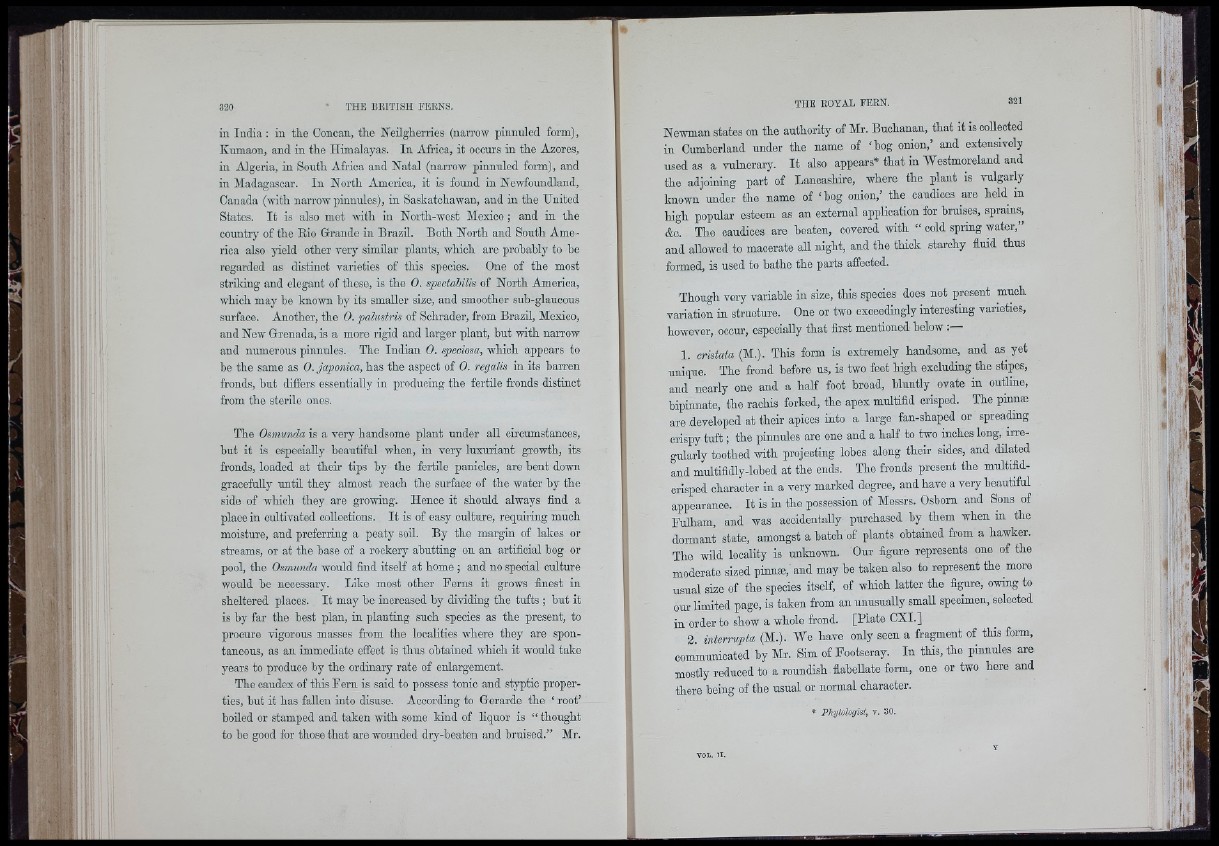
320
in India : in the Conoan, the Neilgherries (narrow pinnuled form),
Kumaon, and in the Himalayas. In Africa, it occurs in the Azores,
in Algeria, in South Africa and Natal (narrow pinnuled form), and
in Madagascar. In North America, it is found in Newfoundland,
Canada (with narrow pinnules), in Saskatohawan, and in the United
States. It is also met with in North-west Mexico ; and in the
country of the Rio Grande in Brazil. Both North and South America
also yield other very similar plants, which aro probably to be
regarded as distinct varieties of this species. One of the most
striking and elegant of these, is the 0. speetahilis of North America,
which may be known hy its smaUer size, and smoother sub-glaucous
surface. Another, the 0. palustris of Schrader, from Brazil, Mexico,
and New Grenada, is a more rigid and larger plant, hut with narrow
and numerous pinnules. The Indian 0. speciosa, which appears to
be the same as 0. japónica, has the aspect of 0. regalis in its barren
fronds, hut differs essentially in producing the fertile fronds distmot
from the sterile ones.
The Osmunda is a very handsome plant under all ciroumstances,
but it is especiaUy beautiful when, in very luxuriant growth, its
fronds, loaded at their tips hy the fertUe panicles, are bent down
gracefully until they almost reach the surface of the water by tho
side of which thoy are growing. Hence it should always find a
place in cultivated coUections. It is of easy culture, requiring much
moisture, and preferring a peaty soU. By the margin of lakes or
streams, or at the base of a rockery abutting on an artificial hog or
pool, the Osmunda would find itself at home ; and no special culture
would he necessary. Like most other Ferns it grows finest in
sheltered places. It may be increased by dividing the tufts ; but it
is by far the best plan, in planting such species as the present, to
procure vigorous masses from the localities where they are spontaneous,
as an immediate effect is thus obtained which it would take
years to produce by the ordinary rate of enlargement.
The caudex of this Fern is said to possess tonic and stjrptio properties,
but it has fallen into disuse. According to Gerarde the ‘ root’
hoUed or stamped and taken with some kind of liquor is “ thought
to he good for those that are wounded dry-beaten and bruised.” Mr.
Newman states on the authority of Mr. Buchanan, that it is coUected
in Cumberland under tho name of ‘bog onion,’ and extensively
used as a vulnerary. It also appears* that in Westmoreland and
tho adjoining part of Lancashire, where the plant is vulgarly
known under the name of ‘hog onion,’ the oaudioes are held in
high popular esteem as an external application for bruises, sprains,
&o. The oaudioes are beaten, covered with “ cold spring water,”
and allowed to macerate all night, and the thick starchy fluid thus
formed, is used to bathe the parts affected.
Though very variable iu size, this species does not present much
variation iu structure. Ono or two exceedingly interesting varieties,
however, occur, especially that first mentioned helow :
1. cristata (M.). This form is extremely handsome, and as yet
unique. The frond before us, is two feet high excluding tho stipes,
and nearly one and a half foot broad, bluntly ovate in outline,
bipinnate, the raohis forked, the apex multifid crisped. The pinnæ
are developed at their apices into a large fan-shaped or spreading
crispy tuft ; the pinnules are one and a half to two inches long, irregularly
toothed with projooting lobes along their sides, and düated
and multifidly-lohod at the ends. The fronds present the multifid-
orisped character in a very marked degree, and have a very beautiful
appearance. It is in tho possession of Messrs. Osborn and Sons of
Fulham, aud was accidentally purchased hy them when in the
dormant state, amongst a batch of plants obtained from a hawker.
The wüd locality is unknown. Our figure represents one of the
moderate sized pinnæ, and may he taken also to represent the more
usual size of the species itself, of which latter the figure, owing to
our limited page, is taken from an unusually small specimen, selected
in order to show a whole frond. [Plate CXI.]
2. interrupta (M.). We have only seen a fragment of this form,
communioated hy Mr. Sim of Footscray. In this, the pinnules are
mostly reduced to a roundish flabellate form, one or two here and
there being of the usual or normal character.
* Phytologist, v. 30.
b /«{i>l1
'l l-
1 i
■■ J
i t ' ]
Í-1 v:l
U'fl
' ‘I
£■
i
I t :
• i